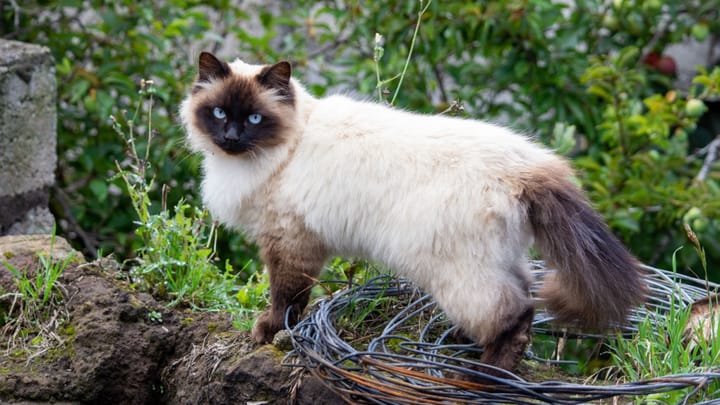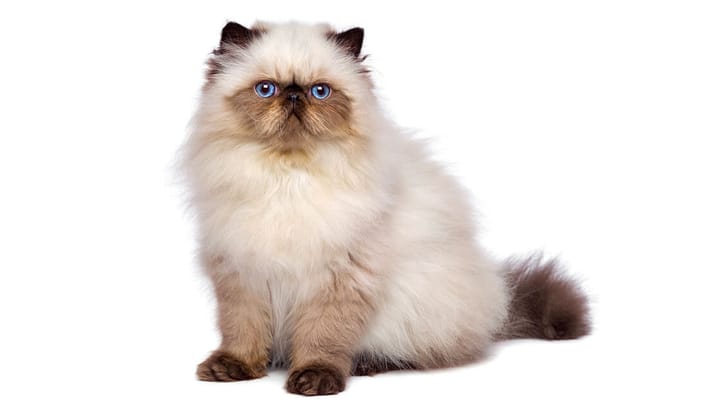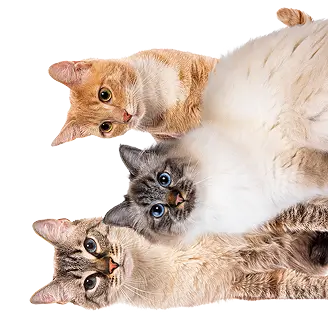Himalayan
Other names : Himalayan Persian, Colourpoint Persian


Taking its name from a breed of rabbits with an identical coat, the Himalayan is a type of Persian. While on the other side of the Atlantic, where they are particularly popular, these cats are considered a breed in their own right, some European countries have classed them as simply a variety of Persian since the 1980s. Their mixture of Persian and Siamese genes makes for a cat that is sweet and affectionate, but also sociable and playful.
|
Life expectancy |
The Himalayan has a life expectancy of between 10 and 15 years |
|
Temperament |
|
|
Adult size |
Female
Between 12 and 14 in
Male
Between 12 and 14 in
|
|
Adult weight |
Female
Between 7 and 11 lb
Male
Between 7 and 11 lb
|
|
Coat colour
Black / seal, blue / slate grey, chocolate, lilac, cinnamon, fawn, red, white |
Black Brown White Red Blue |
|
Type of coat
Long. Their shiny coat boasts a generous undercoat. |
Long |
|
Eye colour
Blue, aquamarine |
Blue
|
|
Purchase price |
The Himalayan costs approximately 500£ |
The Himalayan is a movie star! Sassy, a cat who accompanies two dogs in Homeward Bound (1993) and then in its sequel (1996) is a Colourpoint Persian. A Himalayan also stars alongside Ben Stiller in Meet the Parents (2000) and Meet the Fockers (2004).
More details about the Himalayan
Himalayan: Origins and history
The Himalayan shares the mysterious origins of the Persian, which is thought to have originated from the East. But the first research into this breed began in the United States and Sweden in the 1930s. At the end of 1940s, Great Britain and the United States set up breeding programmes to obtain Colourpoint Persians by crossing black and blue Persians and a semi-long haired Siamese. It wasn’t until 1955 and 1957 that the two countries respectively recognised the breed. Himalayans are quite popular in North America, unlike in Europe where they are not so common.
Physical characteristics of the Himalayan
Their physique is identical to the Persian’s. Medium in size, these are round, robust cats with short legs. They have a strong bone structure and powerful musculature. Their head is broad and round, with little ears on top. In between their two big, round eyes sits a small, turned-up nose with a stop between the eyes. They sport a beautiful, generous collar. Their tail is short and straight and their paws are round and big. The ACFA, the American association of cat breeds, specifies that their front paws must be polydactyl, meaning five-fingered.
Himalayan: Characteristics
Himalayan: Behaviour
Breed compatibility Himalayan
Himalayan: Purchase price
The average purchase price of a Himalayan kitten is approximately £500, with price varying depending on the lineage, breeding, age and even the sex. For your monthly budget you should allow on average £35 per month to meet their needs, by offering them a high-quality diet and ensuring to keep them in good health.
Himalayan: Shedding
Heavy !
Like all Persians, the Himalayan loses a lot of fur.
Himalayan: Grooming
The grooming needs of Himalayans are particularly demanding: they must be brushed daily to prevent knots from developing and to get rid of any dead fur. The easiest way to deal with this is with a bath, followed by a thorough drying. The long fur on their hindquarters can sometimes be soiled by their stool, so it must be checked regularly. Cutting and trimming will be necessary from time to time to make maintenance easier.
Their eyes and the sides of their nose must also be cleaned daily because of the cat’s flat face. Secretions can actually colour their light fur and cause infections. You should also check the cleanliness of their ears regularly.
Himalayan: Health
Himalayans have quite a wide-ranging life expectancy since it depends on the individual and their genetic characteristics. They tend to live for between 10 and 15 years.
These are house cats to a T, and extreme temperatures certainly aren’t for them!
Being such greedy homebodies, these cats can pretty easily become a little overweight. The quality and quantity of food you give them should therefore be closely monitored. Interactive bowls could be a good feeding solution as your cat will be both physically and intellectually stimulated.
Like many cat breeds, Persians - and therefore Himalayans - have a predisposition to certain hereditary diseases:
- Nephrology-urology:
- Polycystic kidney: cysts appear gradually and slowly on the kidneys, hindering their proper functioning. There is a screening test for this disease.
- Idiopathic cystitis: this inflammation of the bladder is often observed in castrated males. There are many causes but they are often unidentified.
- Urolithiasis (or urinary stones): these usually appear after the age of 7, mostly in males and sterilised individuals
- Oncology:
- Basal Cell Tumor: mostly benign, these skin tumors are often located within the head or the neck
- Sebaceous gland tumor: these benign skin tumors can be isolated or multiple
- Cardiology:
- Hypertrophic heart disease: heart disease characterised by thickening of the myocardium
- Pericardial diaphragmatic hernia: anomaly of the development of the diaphragm leading to the abdominal organ passage in the pericardial cavity
- Ophthalmology:
- Progressive atrophy of the retina that causes vision loss almost from birth
- Corneal sequestration (or necrosis of the cornea)
- Coloboma of the eyelids: malformation of the external part of the upper eyelids
- Entropion: malformation causing the edge of the eyelid to fold inwards
- Idiopathic epiphora: tear secretion anomaly relating to the shape of the cat's head
- Dermatology:
- Ringworm: mycosis, normally developing on the back or at the base of the tail, causing ulcerated nodules
- Testicular cryptorchidism / monorchidism: non-descent of both or one testicles
- They can also suffer from the same conditions as all domestic cats, including oral diseases.
It is advisable to carefully monitor your cat’s health from the age of about 7, with annual checkups at the vet.
As with Persians, Himalayans tend to give birth to smaller litters. The labour / farrowing process must be supervised as these cats are at particularly high risk - kittens with a large head may be difficult to expel, and caesarians are quite common.





